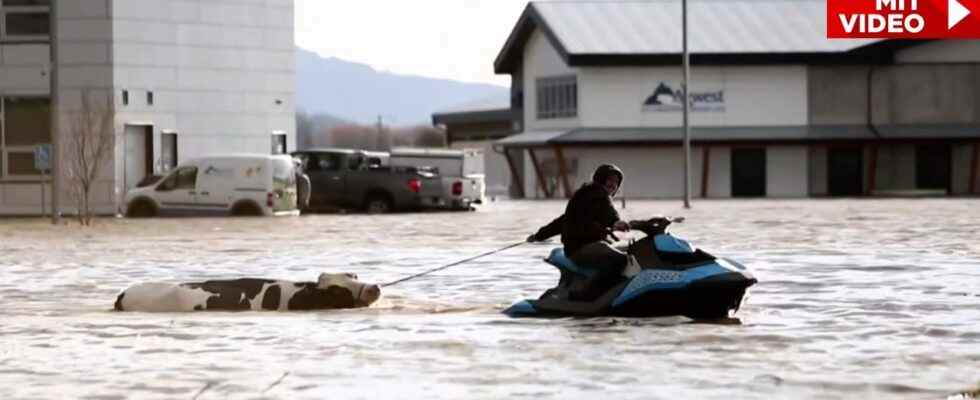Vancouver – Rubble, water everywhere and unbelievable rain. A storm caused flooding and mudslides in Canada.
The result: motorists got stuck in their cars, had to be rescued by helicopter, and towns evacuated. According to the police, a woman died and at least two people are still missing.
It was a record rain that fell over the weekend and into Monday in the Canadian province of British Columbia. The southern part of the region, which borders the USA, was particularly hard hit. Rivers overflowed and several highways were impassable.
A mudslide fell on Highway 99 between Lillooet and Pemberton. Kathie Rennie was there with her husband and son (9).
Scree and tree trunks block a road near Lillooet, CanadaPhoto: BC Ministry of Transportation / Via REUTERS
After a traffic jam, several drivers got out before debris and mud fell down a slope, Rennie reported to “CBS News”: “As soon as we got back into our vehicles, we saw the people in front of us screaming and running. The look on their faces was like a tsunami was coming. It was the most terrible thing I have ever seen. “

A worker rescued a wife and two children in Abbotsford. They were trapped in the waterPhoto: Darryl Dyck / AP

Helpers laid a pipe for a water pump on a housePhoto: ARTUR GAJDA / Reuters
Everything was just swept away, “It was just complete panic”. She observed how three vehicles with around five people were washed away in the mud. According to the police, the body of a woman has now been recovered from Lillooet (around 250 kilometers north of Vancouver).
“The total number of missing people and vehicles” is still unclear, according to a police spokeswoman. There is no trace of at least two people. There are concerns that other people with their vehicles could have been swept away by a mudslide.

Canadian soldiers guide motorists on a road to the rescue helicopter on Monday Photo: RCAF / Reuters

View from the helicopter: After landslides, cars are standing close together on a highway near Agassiz Photo: RCAF / Reuters
Mudslides also damaged other highways on Monday. Hundreds of people who were on their way to Vancouver, for example, had to be rescued by military helicopters.
Because of the rain, authorities had ordered evacuations: Emergency shelters were set up for those affected. The power went out in 9,000 households. Abbotsford Mayor: “It breaks my heart to see what’s going on.”

A Volvo is trapped by the water in Abbotsford, CanadaPhoto: JENNIFER GAUTHIER / Reuters
According to local media, there is still no drinking water and no functioning sewage system in Merritt. It could take more than a week before residents are allowed to return to their homes. All three bridges are impassable – one has collapsed, the other two have to be checked first.
Abbotsford authorities were forced to reassign rural residents Tuesday evening to seek immediate safety. Due to an imminent pumping station failure, there is a threat of a “catastrophic” flooding in the Sumas prairie.

After the rain, a car sank into a water hole next to a road Photo: Jonathan Hayward / AP
What kind of massive rain was that? Graduate meteorologist Dominik Jung from the weather service Q.met to BILD: “It poured a lot, at least 150 liters of rain per square meter in 24 hours. It is mountainous, the water converged like a canal effect. In valleys people got the water masses. It was extremely heavy rain in a short time that could not seep in. “
The precipitation had fallen for days. The rains were apparently caused by an atmospheric river – a huge cloud of moisture that stretched across the Pacific to Washington and Oregon.
